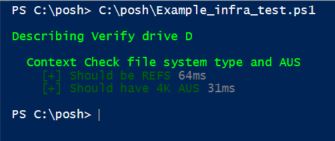In my previous post I explained briefly about the basics of using Pester to test and validate your infrastructure. This article is about how to create/ output custom messages on Pester test failures. Let's have a look at the below example.
#example_test.ps1
Describe "Verify drive D" {
Context "Check file system type and AUS" {
It "Test 1: Should be NTFS" {
$drive_stat = fsutil fsinfo statistics D:
($drive_stat[0]) -match 'File System Type :\s+NTFS' | Should Be $true
}
It "Test 2: Should have 4K AUS" {
$AUS_stat = fsutil fsinfo refsinfo D:
($AUS_stat[8]) -match 'Bytes Per Cluster :\s+4096' | Should Be $true
}
}
}
Describe "Verify Hyper-V vSwitch" {
Context "Check for Corp vSwitch, its type and connected NIC" {
$check = Get-VMSwitch | where name -eq Corp
It "Test 3: Corp vSwitch should be present" {
($check.Name) | Should -BeExactly "Corp"
}
It "Test 4: Corp vSwitch type should be Internal" {
($check.SwitchType) | Should -BeExactly "Internal"
}
}
}
I get the following output, when I run it against one of my test machine.
The above screenshot shows, Test 1 and Test 4 is failed. Eventhough you get the error message, some users/ admins prefer to have a custom message when a test fails. So that it will be very easy to troubleshoot for the one who is validating the infrastructure. To save custom messages for each test, I am using a hash table, and if a test is found to be failed, it will pick the respective custom message from the hash table and displays it and the end of the test. Here I created a new ps1 file as below.
#invoke_test.ps1
$test = Invoke-Pester .\example_test.ps1 -PassThru
$failmsg_table = @{
"Test 1: Should be NTFS" = "Test 1: Failed because the filesystem of drive D is not NTFS"
"Test 2: Should have 4K AUS" = "Test 2: Failed because the AUS of drive D is not 4K"
"Test 3: Corp vSwitch should be present" = "Test 3: Failed becuase Corp vSwitch is not present"
"Test 4: Corp vSwitch type should be Internal" = "Test 4: Failed because Corp vSwitch type is not Internal"
}
for ($i=0; $i -le $test.TotalCount; $i++){
if ($test.TestResult[$i].Result -eq "Failed") {
write-output $failmsg_table[$($test.TestResult[$i].Name)]
}
}
When I execute "invoke_test.ps1", it invokes "example_test.ps1" and the output is saved to variable "test". The hash table has the list of tests and the corresponding custom message. If any of the "TestResult" is Failed, the corresponding custom message will be displayed. Sample output screenshot is given below.
Hope this was useful. Cheers!









